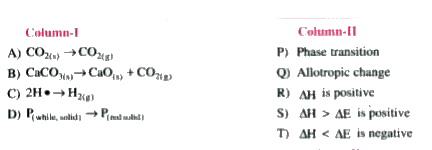The value of ΔH−ΔU for the following reaction at 27∘C will be : N2(g)+3H2(g)→2NH3(g)Solution in Telugu
8.314×273×(−2)J
8.314×300×(−2)J
−600R
8.314×300×2J
The correct Answer is:B, C
ΔH−ΔU=−2RT=(−2)×8.314×300
=−2×R×300
Topper's Solved these Questions
- CHEMICAL THERMODYNAMICSBOOK - AAKASH SERIESCHAPTER - CHEMICAL THERMODYNAMICSEXERCISE - PRACTICE SHEET (EXERCISE- II) (LEVEL- II (ADVANCED) LINKED COMPREHENSION TYPE QUESTIONS)
5 Videos
- CHEMICAL THERMODYNAMICSBOOK - AAKASH SERIESCHAPTER - CHEMICAL THERMODYNAMICSEXERCISE - PRACTICE SHEET (EXERCISE- II) (LEVEL- II (ADVANCED) MATRIX MATCHING TYPE QUESTIONS)
2 Videos
- CHEMICAL THERMODYNAMICSBOOK - AAKASH SERIESCHAPTER - CHEMICAL THERMODYNAMICSEXERCISE - PRACTICE SHEET (EXERCISE- II) (LEVEL- II (ADVANCED) STRAIGHT OBJECTIVE TYPE QUESTIONS)
4 Videos
- CHEMICAL THERMODYANMICS BOOK - AAKASH SERIESCHAPTER - CHEMICAL THERMODYANMICS EXERCISE - Questions For Descriptive Answers
28 Videos
- ELECTRON MIGRATION EFFECTS BOOK - AAKASH SERIESCHAPTER - ELECTRON MIGRATION EFFECTS EXERCISE - QUESTIONS FOR DESCRIPTIVE ANSWERS
10 Videos
Similar Questions
Enthalpy of neutralization is defined as the enthalpy change when 1 mole of acid/base is completely neutralized by base/acid in dilute solution. For strong acid and strong base neutralization net chemical change is H+(aq)+OH−(aq)→H2O(l),ΔH0r≡−55.84kJ/mol
If enthalpy of neutralization of CH3COOH by NaoH is -49.86 kJ/mol then enthalpy of ionisation of CH3COOH is
View SolutionMatch the following columns

View SolutionFor the real gases reaction 2CO(g)+O2(g)→2CO2(g),ΔH=−560kJ. In a 10L rigid vessel at 500K, the initial pressure is 70 bar and after reaction it becomes 40 bar. The change in internal energy is:
View SolutionHow does heat of neutralisation value change with the chemical nature of acid and base?
View SolutionHyperconjugation effect is also termed as 'no bond resonance'. Why?
View SolutionThe enthalpy change (ΔH) for the reaction
N2(g)+3H2(g)→2NH3(g)
is −92.38kJ at 298K. What is ΔU at 298K?
View SolutionFor N_(2)(g) + 3H_(2)(g) rarr 2NH_(3)(g) + 22kcal , E_(a) for the reaction is 70 kcal . Hence, the activation energy for 2NH_(3)(g) rarr N_(2)(g) + 3H_(2) (g) is :
View SolutionThe value of ΔH−ΔE for the following reaction at 27∘C will be
2NH3(g)→N2(g)+3H2(g)
View SolutionThe value of DeltaH - DeltaE for the following reaction at 27^(@)C will be 2NH_(3)(g) rarr N_(2)(g) + 3H_(2)(g)
View SolutionFor the reaction, N_(2)(g)+3H_(2)(g) to 2NH_(3)(g)
View Solutionअभिक्रिया N2(g)+3H2(g)⇔2NH3,ΔH=−92kJ में ताप वृद्धि में साम्यावस्था पर NH3 की सान्द्रता -
View SolutionFor the reaction N2(g)+3H2(g)→2NH3(g) the rate of the reaction in terms of ammonia is __________
View SolutionFor the reaction, 2NH3(g)→N2(g)+3H2(g)-
View SolutionWhich of the following is correct for the reaction? N_(2)(g) + 3H_(2)(g) rarr 2NH_(3)(g)
View SolutionExplain the effect of temperature on the following equilbrium reaction . N_(2)(g)+3H_(2)(g) hArr 2NH_(2)(g)Delta H =- 92.2Kj .
View Solution
